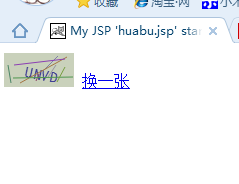直接跳severlet在java后台生成验证码:
@RequestMapping(value="yzm.action")
public void Yzm(HttpSession session,HttpServletResponse resp){
// 验证码图片的宽度。
int width = 60;
// 验证码图片的高度。
int height = 20;
// 验证码字符个数
int codeCount = 4;
int x = 0;
// 字体高度
int fontHeight;
int codeY;
char[] codeSequence = { 'A', 'B', 'C', 'D', 'E', 'F', 'G', 'H', 'I', 'J',
'K', 'L', 'M', 'N', 'O', 'P', 'Q', 'R', 'S', 'T', 'U', 'V', 'W',
'X', 'Y', 'Z', '0', '1', '2', '3', '4', '5', '6', '7', '8', '9' };
x = width / (codeCount + 1);
fontHeight = height - 2;
codeY = height - 4;
BufferedImage buffImg = new BufferedImage(width, height,
BufferedImage.TYPE_INT_RGB);
Graphics2D g = buffImg.createGraphics();
// 创建一个随机数生成器类
Random random = new Random();
// 将图像填充为白色
g.setColor(Color.WHITE);
g.fillRect(0, 0, width, height);
// 创建字体,字体的大小应该根据图片的高度来定。
Font font = new Font("Fixedsys", Font.PLAIN, fontHeight);
// 设置字体。
g.setFont(font);
// 画边框。
// g.setColor(Color.BLACK);
// g.drawRect(0, 0, width - 1, height - 1);
// 随机产生160条干扰线,使图象中的认证码不易被其它程序探测到。
g.setColor(Color.BLACK);
for (int i = 0; i < 1; i++) {
int x2 = random.nextInt(width);
int y2 = random.nextInt(height);
int xl = random.nextInt(12);
int yl = random.nextInt(12);
g.drawLine(x2, y2, x + xl, y2 + yl);
}
// randomCode用于保存随机产生的验证码,以便用户登录后进行验证。
StringBuffer randomCode = new StringBuffer();
int red = 0, green = 0, blue = 0;
// 随机产生codeCount数字的验证码。
for (int i = 0; i < codeCount; i++) {
// 得到随机产生的验证码数字。
String strRand = String.valueOf(codeSequence[random.nextInt(36)]);
// 产生随机的颜色分量来构造颜色值,这样输出的每位数字的颜色值都将不同。
red = random.nextInt(255);
green = random.nextInt(255);
blue = random.nextInt(255);
// 用随机产生的颜色将验证码绘制到图像中。
g.setColor(new Color(red, green, blue));
g.drawString(strRand, (i + 1) * x, codeY);
// 将产生的四个随机数组合在一起。
randomCode.append(strRand);
}
// 将四位数字的验证码保存到Session中。
session.setAttribute("validateCode", randomCode.toString());
ServletOutputStream sos;
try {
sos = resp.getOutputStream();
ImageIO.write(buffImg, "jpeg", sos);
sos.close();
} catch (IOException e) {
// TODO Auto-generated catch block
e.printStackTrace();
}
}jsp显示页面的代码,点击图片刷新
<td><img id="img" src="yzm.action"/>${validateCode}</td>
<td><input type="text" name="yzma"/><br/></td>
$("#img").click(function(){
$(this).attr("src","yzm.action?"+new Date().getTime());
});将文本框中的值传入后台,与最开始生成验证码的随机数进行比较即可完成验证。

页面上拿到的session的值老是比验证码晚一步,所以采取后台进行验证。这里我也不知道什么原因,望小伙伴们告知。。。
另一种思路,后台生成随机数,前端生成画布,用ajax拿随机数
//后台只生成随机数
@RequestMapping(value="random.action")
public void findRandom (HttpServletResponse response) throws IOException{
// 验证码字符个数
int codeCount = 4;
char[] codeSequence = { 'A', 'B', 'C', 'D', 'E', 'F', 'G', 'H', 'I', 'J',
'K', 'L', 'M', 'N', 'O', 'P', 'Q', 'R', 'S', 'T', 'U', 'V', 'W',
'X', 'Y', 'Z', '0', '1', '2', '3', '4', '5', '6', '7', '8', '9' };
// 创建一个随机数生成器类
Random random = new Random();
// randomCode用于保存随机产生的验证码,以便用户登录后进行验证。
StringBuffer randomCode = new StringBuffer();
for (int i = 0; i < codeCount; i++) {
// 得到随机产生的验证码数字。
String strRand = String.valueOf(codeSequence[random.nextInt(36)]);
// 将产生的四个随机数组合在一起。
randomCode.append(strRand);
}
PrintWriter out = response.getWriter();
out.print(randomCode);
}jsp,jq,js代码
<body>
<canvas id="canvas" width="70" height="34"></canvas>
<a href="javascript:;" rel="external nofollow" id="img" class="pull-right" >换一张</a>
<input type="text" class="form-control" id="yzms" name="yzms" readonly = "readonly" >
</body>
<script type="text/javascript">
$.ajax({
url:"random.action",
success:function(k){
console.log(k)
$("#yzms").attr("value",k);
drawPic();
}
})
$("#img").on("click",function(){
var _this=$(this)
$.ajax({
url:"random.action",
success:function(k){
console.log(k)
$("#yzms").attr("value",k);
drawPic();
}
})
})
/**生成一个随机数**/
function randomNum(min,max){
return Math.floor( Math.random()*(max-min)+min);
}
/**生成一个随机色**/
function randomColor(min,max){
var r = randomNum(min,max);
var g = randomNum(min,max);
var b = randomNum(min,max);
return "rgb("+r+","+g+","+b+")";
}
/**绘制验证码图片**/
function drawPic(){
var canvas=document.getElementById("canvas");
var width=canvas.width;
var height=canvas.height;
var ctx = canvas.getContext('2d');
ctx.textBaseline = 'bottom';
/**绘制背景色**/
ctx.fillStyle = randomColor(180,240); //颜色若太深可能导致看不清
ctx.fillRect(0,0,width,height);
/**绘制文字**/
/* for(var i=0; i<4; i++){ */
var txt = $("#yzms").attr("value");
ctx.fillStyle = randomColor(50,160); //随机生成字体颜色
ctx.font = randomNum(15,20)+'px SimHei'; //随机生成字体大小
var x = 20;
var y = randomNum(20,30);
var deg = randomNum(-45, 45);
//修改坐标原点和旋转角度
ctx.translate(x,y);
ctx.rotate(deg*Math.PI/180);
ctx.fillText(txt, 0,0);
//恢复坐标原点和旋转角度
ctx.rotate(-deg*Math.PI/180);
ctx.translate(-x,-y);
/* } */
/* /**绘制干扰线**/
for(var i=0; i<8; i++){
ctx.strokeStyle = randomColor(40,180);
ctx.beginPath();
ctx.moveTo( randomNum(0,width), randomNum(0,height) );
ctx.lineTo( randomNum(0,width), randomNum(0,height) );
ctx.stroke();
}
/**绘制干扰点**/
/* for(var i=0; i<100; i++){
ctx.fillStyle = randomColor(0,255);
ctx.beginPath();
ctx.arc(randomNum(0,width),randomNum(0,height), 1, 0, 2*Math.PI);
ctx.fill();
} */
}效果展示:

总结
以上所述是小编给大家介绍的Java后端产生验证码后台验证功能的实现代码,希望对大家有所帮助,如果大家有任何疑问请给我留言,小编会及时回复大家的。在此也非常感谢大家对亿速云网站的支持!
如果你觉得本文对你有帮助,欢迎转载,烦请注明出处,谢谢!
亿速云「云服务器」,即开即用、新一代英特尔至强铂金CPU、三副本存储NVMe SSD云盘,价格低至29元/月。点击查看>>
免责声明:本站发布的内容(图片、视频和文字)以原创、转载和分享为主,文章观点不代表本网站立场,如果涉及侵权请联系站长邮箱:is@yisu.com进行举报,并提供相关证据,一经查实,将立刻删除涉嫌侵权内容。